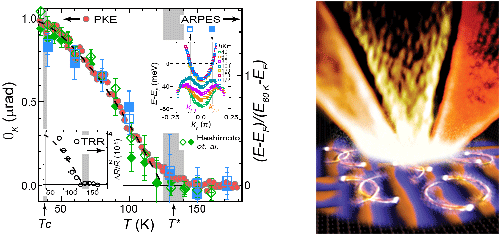The nature of the pseudogap, which exists above the superconducting transition temperature (Tc) of high-Tc cuprate superconductors, is one of the most important unsolved problems in condensed matter physics. Many possible origins for the pseudogap, such as fluctuating superconductivity and competing order, have been proposed, however, since its discovery two decades ago, there has not been a conclusive experiment. Following the previous extensive work on the pseudogap and its relationship with superconductivity from Prof. Zhi-Xun Shen’s group1-3, a study recently published in Science has found the strongest evidence yet that the mysterious pseudogap in electronic structures could indicate a new phase of matter in high-Tc cuprates, which has a complicated interplay with superconductivity. This work has been led by Rui-Hua He and Makoto Hashimoto along with their co-workers in Prof. Zhi-Xun Shen’s group at Stanford University, with an extended strong collaboration with teams of researchers from the Stanford Institute for Materials and Energy Science (led by Aharon Kapitulnik), Lawrence Berkeley National Laboratory (led by Joseph Orenstein) and the Advanced Light Source (led by Zahid Hussain), the sample growers from the National Institute of Advanced Industrial Science and Technology (led by Hiroshi Eisaki), as well as SIMES theorists Steve Kivelson and Thomas Devereaux.
The uniqueness of this study lies in applying three different experimental techniques to the same sample (optimally doped Pb-Bi2201): high-resolution angle-resolved photoemission spectroscopy (ARPES) measurements performed at SSRL Beam Line 5-4; high precision measurements ofpolar Kerr effect (PKE), which has proven to be a sensitive probe of the onset of a broken-symmetry state; and time-resolved reflectivity (TRR) measurements. With these three techniques, which had never before been combined, electronic behavior at the sample's surface covering the entire Fermi surface over wide temperature range, thermodynamic behavior in the sample's interior, and complementary information on the near-equilibrium dynamics of the system have been examined.
As complex oxides, cuprate superconductors belong to a class of materials which exhibit many broken-symmetry states, including the pseudogap state; unraveling the relationship between superconductivity and other possible broken-symmetry states in cuprates has been a major challenge in condensed matter physics. As shown in Fig. 1 (left panel), three different techniques have detected signatures of such symmetry breaking at the same pseudogap onset temperature T*. The right top inset shows the temperature evolution of the band dispersion determined by ARPES in the antinodal region where the pseudogap has maximum gap size. The misalignment between the Fermi momenta defined above T* and dispersion back-bending suggests that the pseudogap opens in a particle-hole asymmetric way. This leads to the conclusion that electrons in the pseudogap phase do not pair up as in the superconducting phase that requires particle-hole symmetric gap opening. At the same time, the PKE results are clearly suggestive of a phase transition at T*, below which a finite Kerr rotation emerges. The strong correlation between the ARPES and PKE data allows us to conjecture a phase transition at T*. TRR data also show that a negative reflectivity change, which has opposite sign from superconductivity signal, turns on at the same pseudogap temperature. This added correspondence further supports the existence of a phase transition at T* into the pseudogap state with near-equilibrium dynamics distinct from superconductivity.
Upon further cooling below Tc, superconductivity features appear on top of the pseudogap in the antinodal region, and the spectral function develops a complex structure with two energy scales of mixed origin. This suggests that the two orders may have a more intimate connection than just competing orders. This complexity has been overlooked before, masked by the behavior of superconducting electron pairs.

Simply considering the pseudogap a new phase of matter makes the high-temperature superconductor roadmap much clearer than before and provides an outline of the next steps: uncover the nature of the pseudogap order, determine whether the pseudogap order is friend or foe to superconductivity, and find a way to promote the pseudogap order if it's a friend and suppress it if it's a foe.
1. K. Tanaka et al., Science 314, 1910 (2006).
2. W. S. Lee et al., Nature 450, 81 (2007)
3. M. Hashimoto and R.-H. He et al., Nat. Phys. 6, 414 (2010).
Rui-Hua He, M. Hashimoto, H. Karapetyan, J. D. Koralek, J. P. Hinton, J. P. Testaud, V. Nathan, Y. Yoshida, Hong Yao, K. Tanaka, W. Meevasana, R. G. Moore, D. H. Lu, S.-K. Mo, M. Ishikado, H. Eisaki, Z. Hussain, T. P. Devereaux, S. A. Kivelson, J. Orenstein, A. Kapitulnik, Z.-X. Shen, Science, 331, 1579-1583 (2011), DOI: 10.1126/science.1198415




